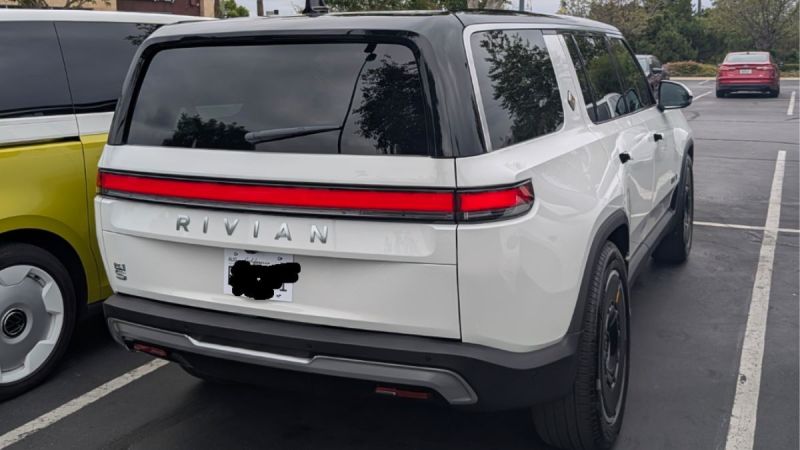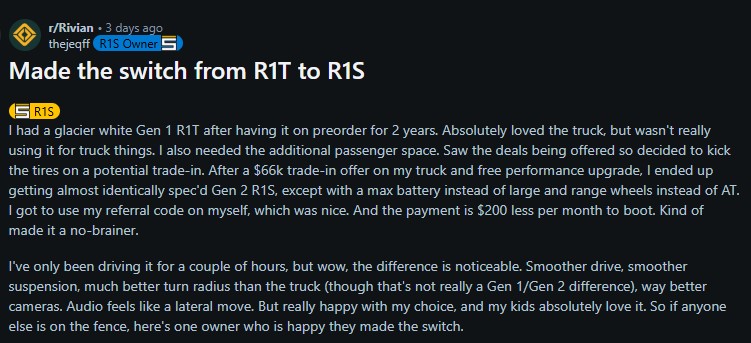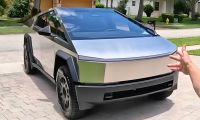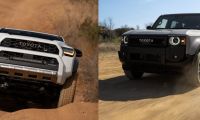Sometimes, a deal materializes in such dramatic fashion that it feels less like savvy consumerism and more like divine intervention. You know the type, the salesman stumbles on the paperwork, the finance numbers lean hard in your favor, and suddenly you're walking away with more car and less payment. It sounds like a myth.
How One Owner Upgraded for More Range and Lower Payments
But for one Rivian owner, that fantasy turned real. In a move that upends typical automotive logic, this driver swapped a well-loved, preordered R1T pickup for a Gen 2 R1S SUV, gaining more range, a smoother ride, better practicality, and somehow shaving $200 off the monthly payment. This wasn’t an emotional decision, it was the cold math of opportunity knocking and being smart enough to open the door.
"I had a glacier white Gen 1 R1T after having it on preorder for 2 years. Absolutely loved the truck, but I wasn't really using it for truck things. I also needed the additional passenger space. Saw the deals being offered, so I decided to kick the tires on a potential trade-in. After a $66k trade-in offer on my truck and free performance upgrade, I ended up getting almost identically spec'd Gen 2 R1S, except with a max battery instead of a large and range wheels instead of AT.
I got to use my referral code on myself, which was nice. And the payment is $200 less per month to boot. Kind of made it a no-brainer. I've only been driving it for a couple of hours, but wow, the difference is noticeable. Smoother drive, smoother suspension, much better turn radius than the truck (though that's not really a Gen 1/Gen 2 difference), way better cameras. Audio feels like a lateral move. But really happy with my choice, and my kids absolutely love it. So if anyone else is on the fence, here's one owner who is happy they made the switch."
– thejeqff, r/Rivian
On the surface, the R1T and R1S look like brothers. Underneath, they share the same electric skateboard chassis and much of Rivian's clever engineering. But don't mistake that for redundancy. These are two machines tuned for very different missions.
R1T vs. R1S Chassis Comparison: Pickup Truck Versus SUV Dynamics
The R1T, with its longer 135.8-inch wheelbase, is the go-anywhere, carry-everything tool. But the R1S, with its 121.1-inch wheelbase and standard third row, is a far more urban-friendly SUV. In real-world driving, that shorter wheelbase translates to one of the most dramatic improvements you can make in a daily driver: a better turning radius. It's not glamorous, but it’s invaluable.
"I just hated the turning radius of the truck."
thejeqff admitted.
"And the smaller wheelbase makes such a huge difference."
It’s a point echoed again and again on r/Rivian and forums across the EV landscape.
“I also went from the R1T to R1S and am thrilled with the change in turning radius.”
Added another user, noteworthybalance. It's rare that someone willingly gives up a truck bed for an SUV body and then claims better handling, but that’s exactly what’s happening here. The R1S moves with more precision and less drama, especially in the tight confines of daily suburban warfare: Trader Joe's parking lots, school pickup lines, and city streets carved by planners who still think cars are twelve feet long.
Gen 2 Upgrades: Enhanced Comfort, Efficiency, and Tech in the Rivian R1S
- Gen 2 models exhibit improved panel alignment, reducing issues like door-fender rubbing and paint wear seen in Gen 1. The suspension system has been refined for a smoother ride, and the cabin is notably quieter, enhancing overall comfort.
- The Gen 2 R1S reduces the number of electronic control units (ECUs) from 17 to 7, streamlining the vehicle's electronics. This consolidation improves computing performance, facilitates over-the-air updates, and introduces features like ultra-wideband support for digital keys.
- Despite a slightly smaller maximum battery capacity (141.5 kWh in Gen 2 vs. 149 kWh in Gen 1), the Gen 2 R1S achieves a longer range of up to 410 miles. This is due to advancements in battery chemistry and weight reduction, enhancing overall efficiency.
And the changes don’t end there. The transition from Rivian’s Gen 1 to Gen 2 platform isn’t merely cosmetic.

According to Rivian, the newer generation features upgraded drive units, refreshed software, revised suspension tuning, and notably sharper cameras, finally bringing the company's driver-assist suite into the modern era.
“Smoother drive, smoother suspension,”
Reported thejeqff. Another R1S owner added that the Gen 2 model felt
“much smoother and quieter."
A shorter wheelbase is supposed to ride rougher, but in this case, it’s the opposite. There’s no logical reason why the R1S should be cushier, but apparently, the laws of physics take a coffee break when Rivian’s engineers get to work.
How a $66K R1T Trade-In Made the R1S Cheaper
The numbers, though, that’s what makes this story almost unbelievable. With a $66,000 trade-in for the R1T (originally bought at preorder pricing), thejeqff leveraged some Rivian luck to land a better-equipped R1S, with the Max battery and range wheels, no less, for less money per month.
"How is it cheaper?!?!"
One Reddit commenter asked, and honestly, it’s a valid question. Rivian’s incentive strategy, combined with the residual value of early R1T builds, created a rare moment of financial alchemy.
“I’ll accept their math and not ask questions,”
Said thejeqff. Smart. Never interrupt a miracle with logic.
But not everything about the R1S is objectively superior.
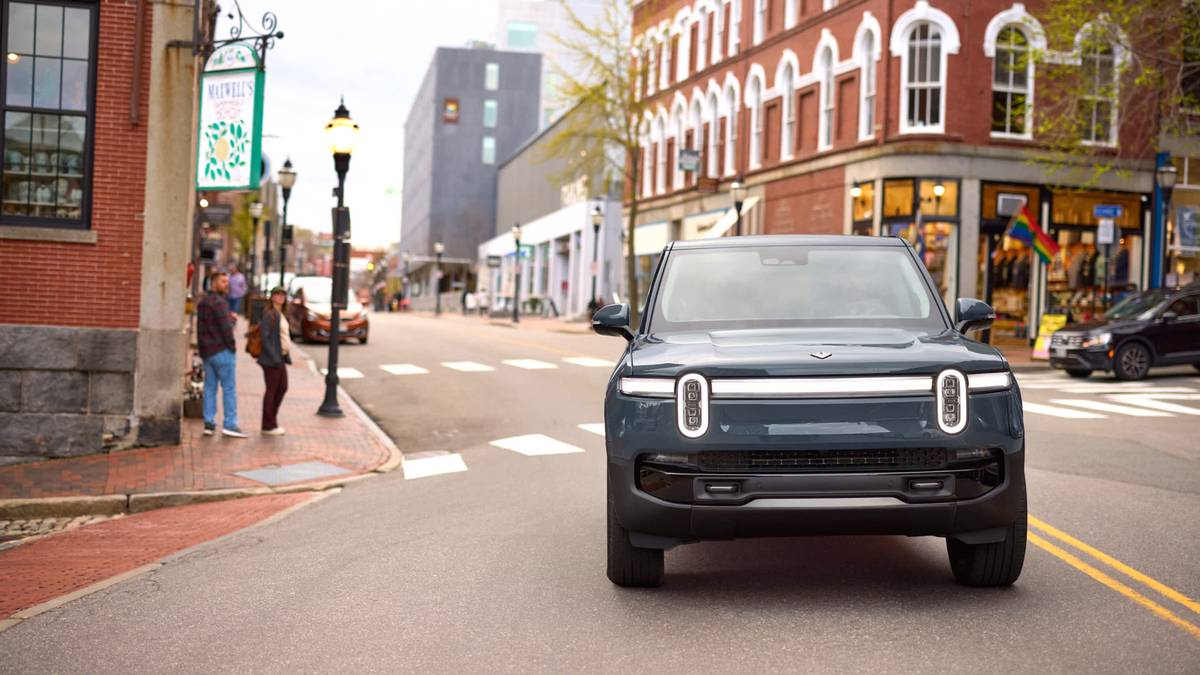
Owners on Rivian forums have pointed out quirks: a slightly more squirrelly launch feel due to the shorter wheelbase, and some uncertainty about rear passenger comfort depending on configuration. One poster lamented the lack of legroom in the third row, saying,
“I wish they'd make a long wheelbase R1S on the same chassis as the R1T.”
Yet in the same breath, they acknowledged that the second row was still “plenty comfortable for an adult.” In practice, the trade-offs seem minor compared to the overall gain in utility and driveability.
What this story ultimately reveals is the shifting reality of EV ownership. Early adopters wanted cool; now they want capable. And the R1S, as it turns out, might just be the more capable of Rivian’s two halo products, not in towing or payload, but in living. In suiting modern life. In giving you that elusive combination of family-hauling, curb-hopping, off-roading, and battery-stretching confidence, all without losing the distinctive Rivian weirdness that made people fall in love with these things in the first place.
R1T vs. R1S Specs: Cargo Capacity, Towing Power, and Maneuverability Compared
- The R1T is a pickup truck featuring a 54-inch cargo bed and a unique Gear Tunnel for additional storage, making it ideal for hauling gear and outdoor equipment. In contrast, the R1S is a three-row SUV that seats up to seven passengers, offering more enclosed space for families and group travel.
- The R1T boasts a higher towing capacity of up to 11,000 pounds, suitable for heavy-duty tasks like towing trailers or boats. The R1S, while still capable, has a lower towing capacity of around 7,700 pounds, reflecting its focus on passenger comfort and versatility.
- With a shorter wheelbase and tighter turning radius, the R1S offers enhanced maneuverability, especially on narrow trails and urban environments. The R1T's longer wheelbase provides stability and a smoother ride on highways, but may be less agile in tight off-road situations.
Plenty of drivers still see the pickup truck as sacred ground, a symbol of grit, utility, and old-school freedom.
To them, trading a bed for a third row might sound like sacrilege. But the numbers don’t lie. When you're offered a newer model with a larger battery, more interior space, a free performance boost, and a lower monthly payment, the romance of the tailgate starts to lose its shine.
Why Switching to the R1S Could Be Your Smartest Rivian Move
This isn’t about giving something up, it’s about gaining exactly what fits your life now. And sometimes, the smartest upgrade isn’t the louder one, it’s the quieter, more comfortable one that still gets the job done, and then some.
Would you trade your R1T for an R1S? Let us know in the comments below what you think about Rivian's line-up and what they should build next.
Image Sources: Rivian Newsroom, Reddit
Noah Washington is an automotive journalist based in Atlanta, Georgia. He enjoys covering the latest news in the automotive industry and conducting reviews on the latest cars. He has been in the automotive industry since 15 years old and has been featured in prominent automotive news sites. You can reach him on X and LinkedIn for tips and to follow his automotive coverage.


